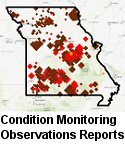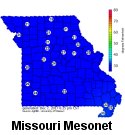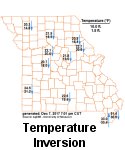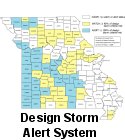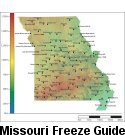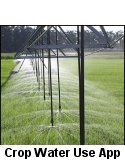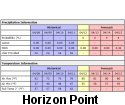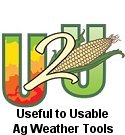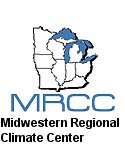
Applying nitrogen to forages now is high risk, low reward
Window closes on applying fall nitrogen for cool-season grass growth.
John Lory
Nutrient Management Specialist
University of Missouri Extension
Email: loryj@missouri.edu
Tim J. Evans
State Specialist, Animal Health and Veterinary Toxicology
University of Missouri Extension
Phone: 573-884-9270
Email: EvansT@missouri.edu
Carson Roberts
State Forage Specialist
University of Missouri Extension
Phone: 208-241-3010
Email: carson.roberts@missouri.edu
Friday, October 18, 2024
COLUMBIA, Mo. - The best time to apply nitrogen fertilizer to promote fall forage growth has passed, says University of Missouri Extension state nutrient management specialist John Lory. Applying now does not promote growth and may increase the risk of forages accumulating nitrate.
The recommended time to apply is late summer, preferably before Aug. 15, says Lory. "Delaying applications after Aug. 15 reduces the probability that the applied nitrogen will maximize yield in cool-season forages such as tall fescue," he says.
Currently, most Missouri pastures are dry with limited forage growth, and no significant precipitation is forecast through Oct. 28. As of Oct. 17, 83% of the state is classified as at least abnormally dry, and 53% is classified as in moderate drought or worse, says MU Extension state climatologist Zachary Leasor.
"Under these conditions there is little chance that nitrogen fertilizer applications will increase fall growth," says Lory. "Spending money on nitrogen fertilizer this late in the season under these dry conditions is high risk, low value. Don't do it."
Many farmers want to apply nitrogen to cool-season pastures later in the season than MU Extension recommends, Lory says. "When we have good soil moisture and significant rainfall through September, farmers may get some value from a later-than-optimal nitrogen application."
However, there is currently little potential for good fall growth, since most soils are dry, says MU Extension state forage specialist Carson Roberts. "Even if we receive rain by the start of November, shorter days and cooler temperatures will limit forage growth."
Up to 50% of the nitrogen applied now will likely to be lost through ammonia volatilization before it has a chance to get into the soil, says Lory. Tall fescue is unlikely to respond to the remaining nitrogen until it starts growing next spring. "If you apply nitrogen now, you are applying to promote spring growth," he says. "Nitrogen to promote spring growth should, ideally, be strategically applied in spring. This will improve fertilizer use efficiency and allow you to make better decisions on which fields need spring nitrogen."
Additionally, applying nitrogen-containing fertilizers could increase the risk of cattle and other ruminants developing nitrate/nitrate poisoning as well as other intoxications, including nonprotein nitrogen or urea poisoning when urea-containing fertilizers are not applied evenly but instead deposited in piles, especially in the absence of rain.
Applying nitrogen-containing fertilizer now will increase risk of nitrate accumulation in several forages, says Tim Evans, MU Extension state specialist in animal health and veterinary toxicology. "If we get rain, cool-season grasses will take up the applied nitrogen, but anticipated cool temperatures will limit growth, potentially resulting in dangerously elevated nitrate concentrations in the resulting forages that can prove fatal for grazing ruminants, especially cattle."
Ingested nitrate in the rumen can be converted to nitrite, which combines with hemoglobin to form methemoglobin, which will not bind to oxygen. Depending on the proportion of methemoglobin in the blood, the clinical signs of nitrate/nitrite poisoning can include exercise intolerance, decreased performance, premature parturition, abortion and possibly even death when most of the hemoglobin has been converted to methemoglobin.
Some MU Extension centers have diphenylamine spot tests on hand to estimate nitrate concentrations in forages, but these test solutions also contain sulfuric acid and should only be used by experienced personnel wearing appropriate protective equipment, including goggles, Evans says.
Evans will be working with MU Extension personnel to develop safer and more accurate "quick testing" protocols for nitrates and suggests that quantitative nitrate analyses performed in laboratories on appropriately collected forage samples will produce the most accurate results. For more information, see the MU Extension publication "Nitrate Problems in Livestock Feed and Water," available for free download at https://extension.missouri.edu/publications/g9800.
In addition, Evans always recommends that only cattle that have already been fed that day should be introduced gradually into new pastures. The first animals introduced to new pastures should be nonpregnant cattle, he adds.
Tall fescue stands need good fertility to sustain and increase yields, Roberts says. Now is a great time to sample the soil and, if needed, adjust pH using lime in anticipation of frost-seeding a legume like red clover. Clover provides nitrogen and increases yields without the negative effects observed in the use of nitrogen-containing fertilizers.
"Save your money and start to plan how to strategically use your money to optimize spring production in 2025," Lory says. "Are you going to apply spring fertilizer? Are you going to frost-seed legumes?" These are the relevant nitrogen management questions to ask now for cool-season grasses, he says.
Source: John Lory, loryj@missouri.edu; Tim J. Evans, 573-884-9270; Carson Roberts, 208-241-3010


